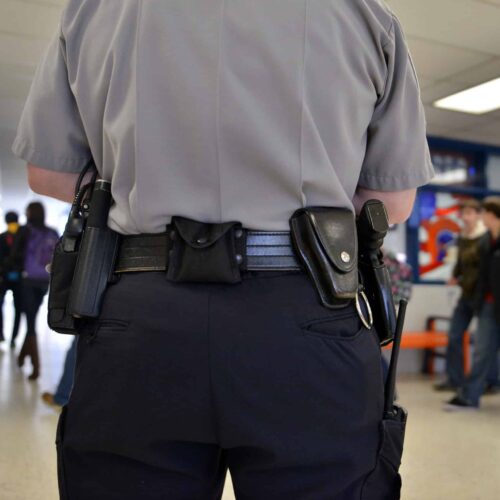This story was produced as part of a collaboration with the Center for Public Integrity and USA TODAY.
Introduction
What is a referral to law enforcement? Does it mean a student was arrested?
A referral occurs when a school employee reports a student to any law enforcement agency or officer, including a school police officer or security staff member for an incident that happens at school, during a school-related event or while taking school transportation, regardless of whether official action is taken.
All arrests are referrals. But not all referrals lead to arrests.
During the 2017-18 school year, nearly 230,000 students were referred to law enforcement. Roughly a quarter of those referrals led to arrests, federal data shows.
The U.S. Department of Education has tweaked the definition of “referral to law enforcement” over time in an effort to include all contact a student may have with officers or security staff that could have negative consequences for the student.
Citations, tickets and court referrals are also considered referrals to law enforcement.
A Center for Public Integrity analysis of U.S. Department of Education data from all 50 states plus the District of Columbia and Puerto Rico found that school policing disproportionately affects students with disabilities, Black children and, in some states, Native American and Latino children.
Despite calls from children’s and civil rights organizations to reduce police presence in schools, these disparities persist. Nationwide, Black students and students with disabilities were referred to law enforcement at nearly twice their share of the overall student population, the Public Integrity analysis found.
What rights do students have when they are referred to law enforcement? Do they have Miranda rights when questioned in connection with a possible crime?

Referrals to law enforcement is such a broad category that it is hard to pinpoint what rights students have. It often depends on the situation, advocates say.
When questioned about an incident that could lead to an arrest, students, in theory, should have the right to refuse to answer questions or provide information to law enforcement or school resource officers. The rules, however, are not always clear on school grounds.
When an officer is based in or assigned to a school, their investigations or interrogations can be viewed differently than those of officers that come in from the outside.
Harold Jordan, a senior policy advocate for the American Civil Liberties Union of Pennsylvania, lays out two different scenarios that could ultimately lead to a student or students being arrested:
In the first, a law enforcement officer walks into a school and informs an administrator, “I’m here to question a student about …” In that situation, known as a custodial interrogation, a student is supposed to be informed of their rights.
In the second scenario, a school resource officer has a conversation where a student discloses something about drug use or possession by themselves or others. Because the student has not been told the officer was investigating something, the student has no reason to suspect it’s an interrogation. But the officer could try to use that information as the basis for an arrest or criminal investigation, Jordan said.
“Even if it’s about somebody else, police will sit you down and ask you a bunch of questions. You don’t automatically know whether you’re the suspect or not,” Jordan said. “So that’s the reason Miranda is important. You have the right to shut up because you have no idea what it is that they’re investigating and how it could be used.”
In 2011, the U.S. Supreme Court ruled in J.D.B. v. North Carolina that police and courts must consider a child’s age when determining whether the child should be read Miranda rights. But there is no federal law that requires it and the decision is left to states.
In Kentucky, for example, the state Supreme Court ruled that students must be given Miranda warnings if a law enforcement officer or school resource officer is present when students are questioned about possible criminal conduct.
Criminal is the key word, though. Students accused of committing minor infractions or violating a student code of conduct would not likely have the same rights.
Are schools required to notify parents or guardians when students are referred to law enforcement?
There is no federal requirement for parent notification, even in situations where a student is questioned about an incident that may lead to an arrest. If there is a policy, it is most likely to be set at the district level.
An agreement between the San Franciso Unified School District and the city police department requires school employees to contact a parent or guardian and give them a reasonable opportunity to be present for any police interrogation, unless the child is a suspected victim of child abuse. In their efforts to contact parents or guardians, school officials in that district must use all numbers listed on an emergency card and any additional numbers supplied by the student. If the parent cannot be reached, the school must offer the student the option of having an adult of their choice from the school available during the interrogation.
In Iowa, children under 14 may not waive their Miranda rights without the consent of an adult such as a parent or guardian.
But advocates caution that few districts or states have policies on the books.
How have school districts tried to address concerns about overuse of law enforcement and bias in school policing?
The Des Moines, Iowa, school district ended its partnership with the city police this year. But administrators are not operating under the assumption that taking officers out of schools will eliminate racial disparities in referrals to law enforcement.
Jake Troja, the district’s director of school climate transformation, said that school employees, who initiate many of the referrals, are partly to blame.
“It isn’t that we’re moving away from the use of law enforcement,” Troja said. “We’re still required to call law enforcement for violations of law. But the overuse of law enforcement is not required.”
A common complaint among school resource officers is that they’re called in by teachers and administrators to manage classroom behavior and student discipline, tasks that fall outside the scope of their assigned duties.
Developing policies and agreements between districts and law enforcement agencies that limit or prohibit officer involvement in routine matters can help reduce referrals and arrests, experts say.
When Thomas Traywick Jr. took over as chief of safety and security for schools in Georgia’s Clayton County in 2016, he prohibited officers from arresting students without permission from supervisors. Working alongside Clayton County Chief Juvenile Court Judge Steven Teske, he doubled down on plans to steer students involved in classroom disruption, disorderly conduct and school fights to conflict-resolution workshops instead of court hearings.
At one point, more than 90% of the referrals that came to Teske’s court were those types of cases, he testified before Congress in 2012. Now, “we very seldom ever see a school-related offense,” he said in a recent interview with Public Integrity.
Traywick said he lost officers who complained that the new approach kept them from doing their jobs effectively. But in his second year leading the district police department, referrals to law enforcement decreased 44%, federal data shows. And that was the right outcome, he said.
“We had to change the mindset of the officers,” Traywick said. “We were criminalizing our kids.”







Join the conversation
Show Comments